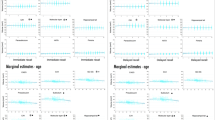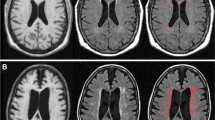Abstract
Both white and grey matter atrophy with age, but it is still unclear how decline in white matter relates to decline in grey matter, and how this relationship varies with age. In a group of healthy adults from 20 to 80 years old, divided into three age groups by tertiles, we cross-sectionally examined the white-to-grey matter associations in the fornix and the hippocampus, and tested if and how the fornix-to-hippocampus relationship differs across the age groups. Both structures were also tested as predictors for performance on a memory test, the Selective Reminding Task (SRT). Participants were imaged with T1-weighted magnetic resonance imaging (MRI) and diffusion-weighted imaging (DWI), from which the hippocampal volume, fractional anisotropy (FA), and mean diffusivity (MD) for the bilateral crus and body of the fornix were calculated. Our data showed that even after accounting for age, sex, and motion parameters, fornix integrity predicted hippocampal volume in the two older age groups (middle and old age) for the crus of the fornix, and only in the oldest age group for the body of the fornix. Furthermore, fornix integrity significantly predicted SRT performance, whereas hippocampal volume did not; this relationship was also observed only in the oldest age group, and absent in the two younger age groups. The age specificity of the relationships suggests that the fornix-to-hippocampus relationship only manifests once brain structures begin to atrophy in old age, and that fornix integrity is a more sensitive measure for episodic memory than is hippocampal volume.



Similar content being viewed by others
References
Adalbert, R., & Coleman, M. P. (2013). Review: Axon pathology in age-related neurodegenerative disorders. Neuropathology and Applied Neurobiology, 39(2), 90–108. https://doi.org/10.1111/j.1365-2990.2012.01308.x.
Baumann, P. S., Griffa, A., Fournier, M., Golay, P., Ferrari, C., Alameda, L., . . . Conus, P. (2016). Impaired fornix-hippocampus integrity is linked to peripheral glutathione peroxidase in early psychosis. Translational Psychiatry, 6(7), e859. https://doi.org/10.1038/tp.2016.117.
Beaulieu, C. (2002). The basis of anisotropic water diffusion in the nervous system - a technical review. NMR in Biomedicine, 15(7–8), 435–455. https://doi.org/10.1002/nbm.782.
Billiet, T., Vandenbulcke, M., Madler, B., Peeters, R., Dhollander, T., Zhang, H., . . . Emsell, L. (2015). Age-related microstructural differences quantified using myelin water imaging and advanced diffusion MRI. Neurobiology of Aging, 36(6), 2107–2121. https://doi.org/10.1016/j.neurobiolaging.2015.02.029.
Buschke, H., & Fuld, P. A. (1974). Evaluating storage, retention, and retrieval in disordered memory and learning. Neurology, 24(11), 1019–1025.
Chiang, S., Levin, H. S., Wilde, E., & Haneef, Z. (2016). White matter structural connectivity changes correlate with epilepsy duration in temporal lobe epilepsy. Epilepsy Research, 120, 37–46. https://doi.org/10.1016/j.eplepsyres.2015.12.002.
Concha, L., Gross, D. W., Wheatley, B. M., & Beaulieu, C. (2006). Diffusion tensor imaging of time-dependent axonal and myelin degradation after corpus callosotomy in epilepsy patients. Neuroimage, 32(3), 1090–1099. https://doi.org/10.1016/j.neuroimage.2006.04.187.
Concha, L., Livy, D. J., Beaulieu, C., Wheatley, B. M., & Gross, D. W. (2010). In vivo diffusion tensor imaging and histopathology of the fimbria-fornix in temporal lobe epilepsy. The Journal of Neuroscience, 30(3), 996–1002. https://doi.org/10.1523/JNEUROSCI.1619-09.2010.
Douet, V., & Chang, L. (2014). Fornix as an imaging marker for episodic memory deficits in healthy aging and in various neurological disorders. Frontiers in Aging Neuroscience, 6, 343. https://doi.org/10.3389/fnagi.2014.00343.
Duvernoy, H., Cattin, F., Risold, P.-Y., & ebrary Inc. (2013). The human hippocampus functional anatomy, vascularization and serial sections with MRI retrieved from http://www.columbia.edu/cgi-bin/cul/resolve?clio10415430.
Fischl, B., Salat, D. H., Busa, E., Albert, M., Dieterich, M., Haselgrove, C., . . . Dale, A. M. (2002). Whole brain segmentation: Automated labeling of neuroanatomical structures in the human brain. Neuron, 33(3), 341–355.
Fischl, B., van der Kouwe, A., Destrieux, C., Halgren, E., Segonne, F., Salat, D. H., . . . Dale, A. M. (2004). Automatically parcellating the human cerebral cortex. Cerebral Cortex, 14(1), 11–22.
Fletcher, E., Raman, M., Huebner, P., Liu, A., Mungas, D., Carmichael, O., & Decarli, C. (2013). Loss of fornix white matter volume as a predictor of cognitive impairment in cognitively normal elderly individuals. JAMA Neurology, 70, 1389–1395. https://doi.org/10.1001/jamaneurol.2013.3263.
Greve, D. N., & Fischl, B. (2009). Accurate and robust brain image alignment using boundary-based registration. Neuroimage, 48(1), 63–72. https://doi.org/10.1016/j.neuroimage.2009.06.060.
He, J., Wong, V. S., Fletcher, E., Maillard, P., Lee, D. Y., Iosif, A. M., . . . DeCarli, C. (2012). The contributions of MRI-based measures of gray matter, white matter hyperintensity, and white matter integrity to late-life cognition. AJNR. American Journal of Neuroradiology, 33(9), 1797–1803. https://doi.org/10.3174/ajnr.A3048.
Hong, Z., Ng, K. K., Sim, S. K., Ngeow, M. Y., Zheng, H., Lo, J. C., . . . Zhou, J. (2015). Differential age-dependent associations of gray matter volume and white matter integrity with processing speed in healthy older adults. Neuroimage, 123, 42–50. https://doi.org/10.1016/j.neuroimage.2015.08.034.
Jenkinson, M., & Smith, S. (2001). A global optimisation method for robust affine registration of brain images. Medical Image Analysis, 5(2), 143–156.
Jenkinson, M., Bannister, P., Brady, M., & Smith, S. (2002). Improved optimization for the robust and accurate linear registration and motion correction of brain images. Neuroimage, 17(2), 825–841.
Marner, L., Nyengaard, J. R., Tang, Y., & Pakkenberg, B. (2003). Marked loss of myelinated nerve fibers in the human brain with age. The Journal of Comparative Neurology, 462(2), 144–152. https://doi.org/10.1002/cne.10714.
Mielke, M. M., Okonkwo, O. C., Oishi, K., Mori, S., Tighe, S., Miller, M. I., . . . Lyketsos, C. G. (2012). Fornix integrity and hippocampal volume predict memory decline and progression to Alzheimer's disease. Alzheimers Dement, 8(2), 105–113. https://doi.org/10.1016/j.jalz.2011.05.2416.
Pakkenberg, B., & Gundersen, H. J. (1997). Neocortical neuron number in humans: Effect of sex and age. The Journal of Comparative Neurology, 384(2), 312–320.
Pardini, M., Bergamino, M., Bommarito, G., Bonzano, L., Luigi Mancardi, G., & Roccatagliata, L. (2014). Structural correlates of subjective and objective memory performance in multiple sclerosis. Hippocampus, 24(4), 436–445. https://doi.org/10.1002/hipo.22237.
Quenon, L., Dricot, L., Woodard, J. L., Hanseeuw, B., Gilis, N., Lhommel, R., & Ivanoiu, A. (2016). Prediction of free and cued selective reminding test performance using volumetric and amyloid-based biomarkers of Alzheimer's disease. Journal of the International Neuropsychological Society, 22(10), 991–1004. https://doi.org/10.1017/S1355617716000813.
Song, S. K., Sun, S. W., Ju, W. K., Lin, S. J., Cross, A. H., & Neufeld, A. H. (2003). Diffusion tensor imaging detects and differentiates axon and myelin degeneration in mouse optic nerve after retinal ischemia. Neuroimage, 20(3), 1714–1722.
Steenwijk, M. D., Daams, M., Pouwels, P. J., L, J. B., Tewarie, P. K., Geurts, J. J., . . . Vrenken, H. (2015). Unraveling the relationship between regional gray matter atrophy and pathology in connected white matter tracts in long-standing multiple sclerosis. Human Brain Mapping, 36(5), 1796–1807. https://doi.org/10.1002/hbm.22738.
Storsve, A. B., Fjell, A. M., Yendiki, A., & Walhovd, K. B. (2016). Longitudinal changes in white matter tract integrity across the adult lifespan and its relation to cortical thinning. PLoS One, 11(6), e0156770. https://doi.org/10.1371/journal.pone.0156770.
Stricker, N. H., Salat, D. H., Foley, J. M., Zink, T. A., Kellison, I. L., McFarland, C. P., . . . Leritz, E. C. (2013). Decreased white matter integrity in neuropsychologically defined mild cognitive impairment is independent of cortical thinning. Journal of the International Neuropsychological Society, 19(8), 925–937. https://doi.org/10.1017/S1355617713000660.
Yendiki, A., Panneck, P., Srinivasan, P., Stevens, A., Zollei, L., Augustinack, J., . . . Fischl, B. (2011). Automated probabilistic reconstruction of white-matter pathways in health and disease using an atlas of the underlying anatomy. Frontiers in Neuroinformatics, 5, 23. https://doi.org/10.3389/fninf.2011.00023.
Zhang, H., Schneider, T., Wheeler-Kingshott, C. A., & Alexander, D. C. (2012). NODDI: Practical in vivo neurite orientation dispersion and density imaging of the human brain. Neuroimage, 61(4), 1000–1016. https://doi.org/10.1016/j.neuroimage.2012.03.072.
Zhuang, L., Sachdev, P. S., Trollor, J. N., Reppermund, S., Kochan, N. A., Brodaty, H., & Wen, W. (2013). Microstructural white matter changes, not hippocampal atrophy, detect early amnestic mild cognitive impairment. PLoS One, 8(3), e58887. https://doi.org/10.1371/journal.pone.0058887.
Funding
This study was funded by National Institute of Health/Aging under grant numbers K01AG051777, RF1AG038465, and R01AG026158.
Author information
Authors and Affiliations
Corresponding author
Ethics declarations
Ethical approval
Participants in this study were treated in accordance with the ethical standards of the Columbia University Institutional Review Board. They were only tested after they had a complete understanding of the risks and benefits involved in this research and had provided written consent for participation and use of their data.
Conflict of interest
All authors declare that they have no conflict of interest.
Rights and permissions
About this article
Cite this article
Gazes, Y., Li, P., Sun, E. et al. Age specificity in fornix-to-hippocampus association. Brain Imaging and Behavior 13, 1444–1452 (2019). https://doi.org/10.1007/s11682-018-9958-1
Published:
Issue Date:
DOI: https://doi.org/10.1007/s11682-018-9958-1




